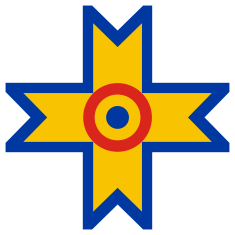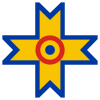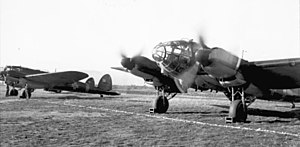Royal Romanian Air Force
This article needs additional citations for verification. (September 2007) |
| Romanian Royal Aeronautics | |
|---|---|
| Aeronautica Regală Română | |
 Insignia | |
| Active | 1924 – 1947 |
| Country | |
| Allegiance | King of Romania |
| Type | Air Force |
| Role | Aerial warfare |
| Part of | Royal Romanian Armed Forces |
| Garrison/HQ | Bucharest |
| Nickname(s) | ARR |
| Colours | Yellow and Blue |
| Engagements | |
| Commanders | |
| General Inspector of the Aeronautics | Carol II of Romania (1924-1925) |
| Minister of the Air and Navy[1] | Radu Irimescu (1936-1938) |
| Insignia | |
| Roundel |  |
| Insignia |  |
The Air Force branch of the Royal Romanian forces in World War II was officially named the Aeronautica Regală Română (ARR), or the Romanian Royal Aeronautics, though it is more commonly referred to in English histories as the Forțele Aeriene Regale ale României (Royal Romanian Air Force, FARR), or simply Forțele Aeriene Române (Romanian Air Force). It provided support to land forces, carrying out reconnaissance and mounting air raids between other missions.
Insignia
The roundel of the ARR was based on the national cockade of Romania. During World War Two, from 1941 to 1944, the national cockade was reduced in size and placed in the center of a four-M cross, the seal of King Michael I of Romania. These crosses came in different types and sizes as there was no standard model. The markings were placed on the fuselage as well as on the upper and lower wings, and the national colours were painted on the tail. According to Axis regulations, the engine cowling, the under-surfaces of the wingtips and a vertical band on the fuselage ahead of the tail were painted in yellow. After Romania joined the Allies, the crosses were changed back to the tricolor roundels on the fuselage and wings, and the yellow markings were painted white as "Allied identification markings".[2]
History
The ARR was first established on 1 January 1924 from the previous Romanian Air Corps.[3]
During the Second World War, the ARR flew aircraft from Germany and Italy, with their own and other foreign aircraft, as well as captured enemy aircraft. The Royal Romanian Air Force fought against the Magyar Királyi Honvéd Légierö (Royal Hungarian Air Force) during the Hungarian annexation of Northern Transylvania in 1940. The most basic unit of their formations was the squadron (Escadrilă). The Royal Romanian Air Force fought alongside the Luftwaffe during the advance into Ukraine and Crimea, until the Battle of Stalingrad, when the Southern Luftwaffe Command was installed in Bucharest. It also carried out some reconnaissance and patrol missions over the Black Sea alongside Bulgarian units. The ARR was tasked with the air defence of the Ploiești oil installations, and also Bucharest against Allied air raids, and to protect Axis convoys in the Black Sea. These units fought against the USAAF and RAF during their raids against Romania.
The main models of aircraft used include the PZL P.24F, Hawker Hurricane, Heinkel He 112, Messerschmitt 109E and G types, Messerschmitt 110 (for night defence), IAR 80A were used too, alongside other types of interceptors used by the Luftwaffe units in area.
After King Michael's Coup, Romania turned against the Axis. The ARR, now allied with the Soviet Air Forces fought against German and Hungarian forces in Transylvania and Slovakia.
Romanian Air Aces
- Horia Agarici
- Mihai (Leu) Romanescu
- Constantin Cantacuzino
- Cristea Chirvăsuță
- Ioan Dicezare
- Tudor Greceanu
- Ioan Maga
- Ioan Mălăcescu
- Ion Milu
- Ion Mucenica
- Constantin Lungulescu
- Alexandru Șerbănescu
- Dan Valentin Vizanty
Structure
- Corpul 2° Aerian, Luftflotte 4, South Russia Front, Winter of 1943-44.
- Corpul 1° Aerian, Cioara-Dolcesti, Romania August 1944; under orders of Luftwaffe, Luftflotte Kommando 4 with commands in Debrecen, Hungary.
Fighter units
- 1st Figher Group (Grupul 1 Vânătoare)
- 41st Fighter Squadron
- 42nd Fighter Squadron
- 2nd Fighter Group (Grupul 2 Vânătoare)
- 45th Fighter Squadron
- 46th Fighter Squadron
- 5th Fighter Group (Grupul 5 Vânătoare)
- 10th Fighter Squadron - 51st Fighter Squadron from October 1939
- 11th Fighter Squadron - 52nd Fighter Squadron from October 1939
- 6th Fighter Group (Grupul 6 Vânătoare)
- 62nd Fighter Squadron
- 63rd Fighter Squadron
- 7th Fighter Group (Grupul 7 Vânătoare)
- 53rd Fighter Squadron
- 57th Fighter Squadron
- 8th Fighter Group (Grupul 8 Vânătoare) - from 1941 - 1943
- 59th Fighter Squadron
- 60th Fighter Squadron
- 9th Fighter Group (Grupul 9 Vânătoare)
- 47th Fighter Squadron
- 48th Fighter Squadron
- 1st Night Fighter Squadron (Escadrila 1 Vânătoare de Noapte)
Bomber units

- 1st Bomber Group (Grupul 1 Bombardament)
- 2nd Bomber Group (Grupul 2 Bombardament)
- 3rd Bomber/Dive Bomber Group (Grupul 3 Bombardament/picaj)
- 4th Bomber Group (Grupul 4 Bombardament)
- 5th Bomber Group (Grupul 5 Bombardament)
- 6th Bomber / Dive Bomber Group (Grupul 6 Bombardament/picaj)
- 8th Assault Group (Grupul 8 Asalt) - formed from the 8th Fighter Group
- 41st Assault Squadron - ex-41st Fighter Squadron
- 42nd Assault Squadron - ex-42nd Fighter Squadron
- 60th Assault Squadron - ex-60th Fighter Squadron
- 18th Light Bomber Squadron
Reconnaissance Units

- 1st Long Range Recon Group (Grupul 1 Recunoaștere Îndepărtată)
- 1st Long Range Recon Squadron
- 2nd Long Range Recon Squadron
- 3rd Long Range Recon Squadron
- 4th Long Range Recon Squadron
- 1st Guard Group
- 2nd Guard Group
Transport Units
- Air Transport Group (Grupul de Aero-Transport)
- 105th Transport Squadron
- 106th Transport Squadron
- 107th Transport Squadron
- 108th Light Transport Squadron - known as Escadrila Albă ("White Squadron")
- 109th Glider Transport Squadron
Liaison Units
- 111th, 112th, 113th, 115th, 116th Liaison Squadrons (Escadrile de Legătură)
Aircraft companies
- Arsenalul Aeronautic, 1919-1939, Bucharest
- Astra Aircraft Factory, 1923-1925, Arad
- Societatea Pentru Exploatări Tehnice (SET), 1923-1946, Bucharest
- Industria Aeronautică Română (IAR), 1925-1947 (re-established in 1968), Brașov
- Întreprinderea de Construcții Aeronautice Românești (ICAR), 1932-1951, Bucharest
Aircraft constructed under foreign license or assembled
- Messerschmitt Bf 109G (62 109Ga-6 converted from Ga-4 kits, 49 109Ga-2 and 13 109Ga-4 assembled by IAR between 1943 and 1948)[4]
- SM.79B (36 IAR JRS-79B and 31 JRS-79B1 built by IAR)
- Fieseler Fi 156 Storch (80 ordered from ICAR)[5]
- PZL P.24E (50 examples built by IAR)
- PZL P.11f (80 examples built by IAR)
- Potez 25 (built under license by IAR)
Enemy aircraft interned or captured
As a result of the Soviet Invasion of Poland, a large number of Polish Air Force aircraft were interned in Romania. Also, some Soviet aircraft were captured during World War II, as well as a few American B-24 Liberator bombers.
Aircraft of RRAF
Aircraft manufactured in Romania from 1924 until the end of World War II
All of the aircraft listed below were completed before the end of World War II. Prototypes are omitted from the list. Unless specified otherwise, all aircraft machine guns have the caliber of 7.92 mm:[6][7]
| Model | Type | Number | Armament |
|---|---|---|---|
| Proto 2 | Training | 25 | Unarmed[8] |
| SET 7K | Training, communication, observation | 20 | 2 x 7.7 mm Lewis guns (twin mount) |
| SET 7KB | Reconnaissance and observation | 20 | 2 x 7.7 mm Lewis guns (twin mount) 1 x 7.7 mm Vickers machine gun 6 x 12 kg bombs |
| SET 7KD | Communication | 20 | 1 x 7.7 mm Lewis gun |
| Potez 25 | Reconnaissance bomber | 184 | 3 x 7.7 mm machine guns 200 kg of bombs |
| IAR 37 | Light bomber | 50 | 4 x Browning machine guns 12 x 50 kg bombs |
| IAR 38 | Reconnaissance and artillery spotting | 75 | 3 x Browning machine guns 24 x 12 kg bombs |
| IAR 39 | Reconnaissance and light bomber | 255 | 3 x Browning machine guns 24 x 12 kg bombs |
| Fieseler Fi 156 | Reconnaissance and communications | 46[a] | 1 x MG 15 machine gun |
| Fleet 10G | Training and communications | 415 | Unarmed |
| PZL P.11f | Fighter | 95 | 4 x FN Browning machine guns 24 x 12 kg bombs (38) Grenade launchers (57) |
| PZL P.24E | Fighter | 25 | 2 x machine guns 2 x 20 mm cannons 2 x 50 kg (110 lb) bombs Grenade launchers |
| Bf 109Ga-2 | Fighter | 49 | 1 x 20 mm/3 x 20 mm MG 151 cannons 2 x MG 17 machine guns 1 x 500 kg/4 x 50 kg bomb(s) |
| Bf 109Ga-4 | Fighter | 13 | 1 x 20 mm MG 151 cannon 2 x MG 17 machine guns 1 x 250 kg/4 x 50 kg bomb(s) |
| Bf 109Ga-6 | Fighter | 62[b] | 1 x 20 mm MG 151 cannon 2 x 13 mm MG 131 heavy machine guns 1 x 250 kg bomb |
| IAR 80 | Fighter | 50 | 4 x FN Browning machine guns |
| IAR 80A | Fighter | 90 | 6 x FN Browning machine guns |
| IAR 80B | Fighter | 50 | 2 x 13.2 mm FN Browning heavy machine guns 4 x FN Browning machine guns |
| IAR 80C | Fighter | 60 | 2 x 20 mm Ikaria autocannons 4 x FN Browning machine guns |
| IAR 81 | Fighter and dive bomber | 50 | 6 x FN Browning machine guns (4 for 10 of them) 2 x 13.2 mm FN Browning heavy machine gun (10 of them) 1 x 225 bomb 2 x 50 kg bombs |
| IAR 81C | Fighter | 150 | 2 x 20 mm MG 151 autocannons 2 x FN Browning machine guns 2 x Werfer-Granate 21 (tested on one aircraft in 1944) |
| JRS-79B | Bomber | 36 | 5 x machine guns 1,575 kg of bombs |
| JRS-79B1 | Bomber | 31 | 1 x 20 mm Ikaria autocannon 7 x machine guns 1,400 kg of bombs |
| Savoia-Marchetti SM.62 | Flying boat | 5 | 4 x machine guns 600 kg of bombs |
Aircraft Markings
Cross used only on the IAR-80/81.[2]
Notes
References
- ^ "Anul 1936". RoAF.
- ^ a b Teodor Liviu Moroșanu; Dan Melinte (30 November 2010). Romanian Fighter Colors 1941-1945. MMPBooks. ISBN 978-8389450906.
{{cite book}}: CS1 maint: uses authors parameter (link) - ^ "Anul 1920". RoAF (in Romanian).
- ^ Dan Antoniu (23 April 2017). "O enigmă elucidată". art-emis (in Romanian).
- ^ a b Horia Stoica, Vasile Radu (2018). German aircraft in Romania - Fieseler Fi 156 Storch. Host Models.
{{cite book}}: CS1 maint: uses authors parameter (link) - ^ Mark Axworthy, London: Arms and Armour, 1995, Third Axis, Fourth Ally: Romanian Armed Forces in the European War, 1941–1945, pp. 239-272
- ^ Dan Antoniu (2014). Illustrated History of Romanian Aeronautics. p. 89. ISBN 978-973-0-17209-6.
- ^ Ion Gudju, Gheroghe Iacobescu, Ovidiu Ionescu (1974). Romanian Aeronautical Constructions 1905-1974 (PDF).
{{cite book}}: CS1 maint: uses authors parameter (link)
Bibliography
- Axworthy, Mark (September–October 1999). "Flank Guard: Romania's Advance on Stalingrad, Part Two". Air Enthusiast (65): 72–75. ISSN 0143-5450.
- Bernád, Dénes (July 1999). "Courrier des Lecteurs" [Readers' Letters]. Avions: Toute l'aéronautique et son histoire (in French) (76): 15–16. ISSN 1243-8650.
- Bernád, Dénes (May 1999). "Histoire des forces aeriennes royales roumaines pendant la Seconde Guerre Mondiale" [History of the Royal Romanian Air Force During the Second World War]. Avions: Toute l'Aéronautique et Son Histoire (in French) (74): 7–13. ISSN 1243-8650.
- Bernád, Dénes (June 1999). "Histoire des forces aeriennes royales roumaines pendant la Seconde Guerre Mondiale". Avions: Toute l'Aéronautique et Son Histoire (in French) (75): 7–14. ISSN 1243-8650.
- Passingham, Malcolm & Noël, Jean (January 1990). "Les avions militaires roumains de 1910 à 1945 (5)" [Romanian Military Aircraft from 1910 to 1945, Part 5]. Le Fana de l'Aviation (in French) (242): 40–43. ISSN 0757-4169.
- Passingham, Malcolm & Noël, Jean (February 1990). "Les avions militaires roumains de 1910 à 1945 (6)" [Romanian Military Aircraft from 1910 to 1945, Part 6]. Le Fana de l'Aviation (in French) (243): 38–42. ISSN 0757-4169.
- Passingham, Malcolm & Noël, Jean (March 1990). "Les avions militaires roumains de 1910 à 1945 (7)" [Romanian Military Aircraft from 1910 to 1945, Part 7]. Le Fana de l'Aviation (in French) (244): 37–41. ISSN 0757-4169.
- Passingham, Malcolm; Noël, Jean (April 1990). "Les avions militaires roumains de 1910 à 1945 (8)" [Romanian Military Aircraft from 1910 to 1945, Part 8]. Le Fana de l'Aviation (in French) (245): 42–46. ISSN 0757-4169.
External links
- Pages with short description
- CS1 maint: uses authors parameter
- CS1 Romanian-language sources (ro)
- Articles needing additional references from September 2007
- All articles needing additional references
- Articles containing Romanian-language text
- Articles with short description
- Short description with empty Wikidata description
- CS1 French-language sources (fr)
- Romanian Air Force
- Military history of Romania during World War II






![Cross used only on the IAR-80/81.[2]](https://upload.wikimedia.org/wikipedia/commons/thumb/e/ec/Roundel_of_the_Romanian_Air_Force_%281941-1944%29.svg/120px-Roundel_of_the_Romanian_Air_Force_%281941-1944%29.svg.png)